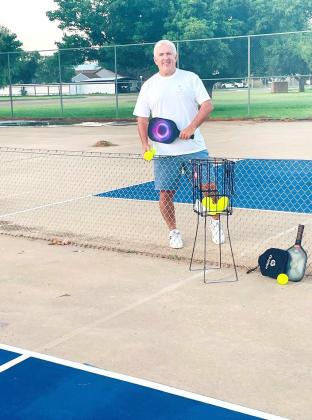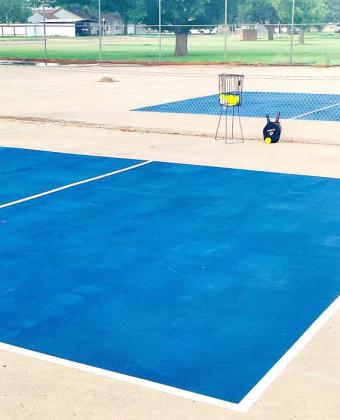The Mayor and City Council of Amherst recently completed a new pickleball court in Amherst.
Pickleball is the fastest growing sport in America, and according to Mark Yarbrough, who has done some research on the topic, stated that he believes Amherst is the smallest city in the nation with an official pickelball court.
“I found a city in Michigan with a population of 2,000, but I could find any smaller than that,” he explained.
The City used grant funds, donations and the hard work of its citizens to build the court.
Those who helped with this project are Richard Salazar, Jennifer Sawyer, Kimberly Brantley, Juanita Garza, Jan Miller, Maria Gonzalez, Rd Gas, Yahir Garcia and Mattie Seymore.
A Brief History
According to the USA Pickelball website, Pickleball was invented in 1965 on Bainbridge Island, a short ferry ride from Seattle, Washington. Three dads – Joel Pritchard, Bill Bell, and Barney McCallum — whose kids were bored with their usual summertime activities — are credited for creating game. Pickleball has evolved from original handmade equipment and simple rules into a popular sport throughout the US and Canada. The game is growing internationally as well, with many European and Asian countries adding courts.
The Rules
Pickleball is played either as doubles (two players per team) or singles; doubles is most common. The same size playing area and rules are used for both singles and doubles.
The Serve
The server’s arm must be moving in an upward arc when the ball is struck and paddle contact with the ball must not be made above the waist level. The head of the paddle must not be above the highest part of the wrist at contact.
A ‘drop serve’ is also permitted, in which case none of the elements above apply.
At the time the ball is struck, the server’s feet may not touch the court or outside the imaginary extension of the sideline or centerline and at least one foot must be behind the baseline on the playing surface or the ground behind the baseline.
The serve is made diagonally crosscourt and must land within the confines of the opposite diagonal court. Only one serve attempt is allowed per server.
Serving Sequence
Both players on the serving doubles team have the opportunity to serve and score points until they commit a fault (except for the first service sequence of each new game). The first serve of each side-out is made from the right/ even court.
If a point is scored, the server switches sides and the server initiates the next serve from the left/ odd court. As subsequent point are scored, the server continues switching back and forth until a fault is committed, and the first server loses the serve.
When the first server loses the serve the partner then serves from their correct side of the court (except for the first service sequence of the game). The second server continues serving until his team commits a fault and loses the serve to the opposing team.
Once the service goes to the opposition (at side-out), the first serve is from the right/even court and both players on that team have the opportunity to serve and score points until their team commits two faults.
In singles, the server serves from the right/even court when his or her score is even and from the left/odd court when the score is odd.
At the beginning of each new game only one partner on the serving team has the opportunity to serve before faulting, after which the service passes to the receiving team.
Scoring
Points are scored only by the serving team and games are normally played to 11 points, win by two. In Tournaments, games may be played to 15 or 21, win by two.
Two-Bounce Rule
When the ball is served, the receiving team must let it bounce before returning, and then the serving team must let it bounce before returning, thus two bounces. After the ball has bounced once in each team’s court, both teams may either volley the ball (hit the ball before it bounces) or play it off a bounce (ground stroke). The twobounce rule eliminates the serve and volley advantage and extends rallies.
Line Calls
A ball contacting any part of any line, except the non-volley zone line on a serve, is considered “in.” A serve contacting the non-volley zone line is short and a fault.
Non-Volley Zone The non-volley zone is the court area within seven feet on both sides of the net. Volleying is prohibited within the non-volley zone. This rule prevents players from executing smashes from a position within the zone.
It is a fault if, when volleying a ball, the player steps on the nonvolley zone, including the line and/ or when the player’s momentum causes them or anything they are wearing toor carrying to touch the non-volley zone including the associated lines. Declared dead before this happens.
A player may legally be in the non-volley zone any time other than when volleying a ball. The non-volley zone is commonly referred to as “the kitchen.”
Faults
A fault is any action that stops play because of a rule violation. A fault by the receiving team results in a point for the serving team. A fault by the serving team results in the server’s loss of serve or side out.
For more information about Pickleball you can visit usapickleball.org.
The Amherst 100th Celebration will be Saturday, July 29th, and they will be hosting a Pickelball Tournament as well as other events.


